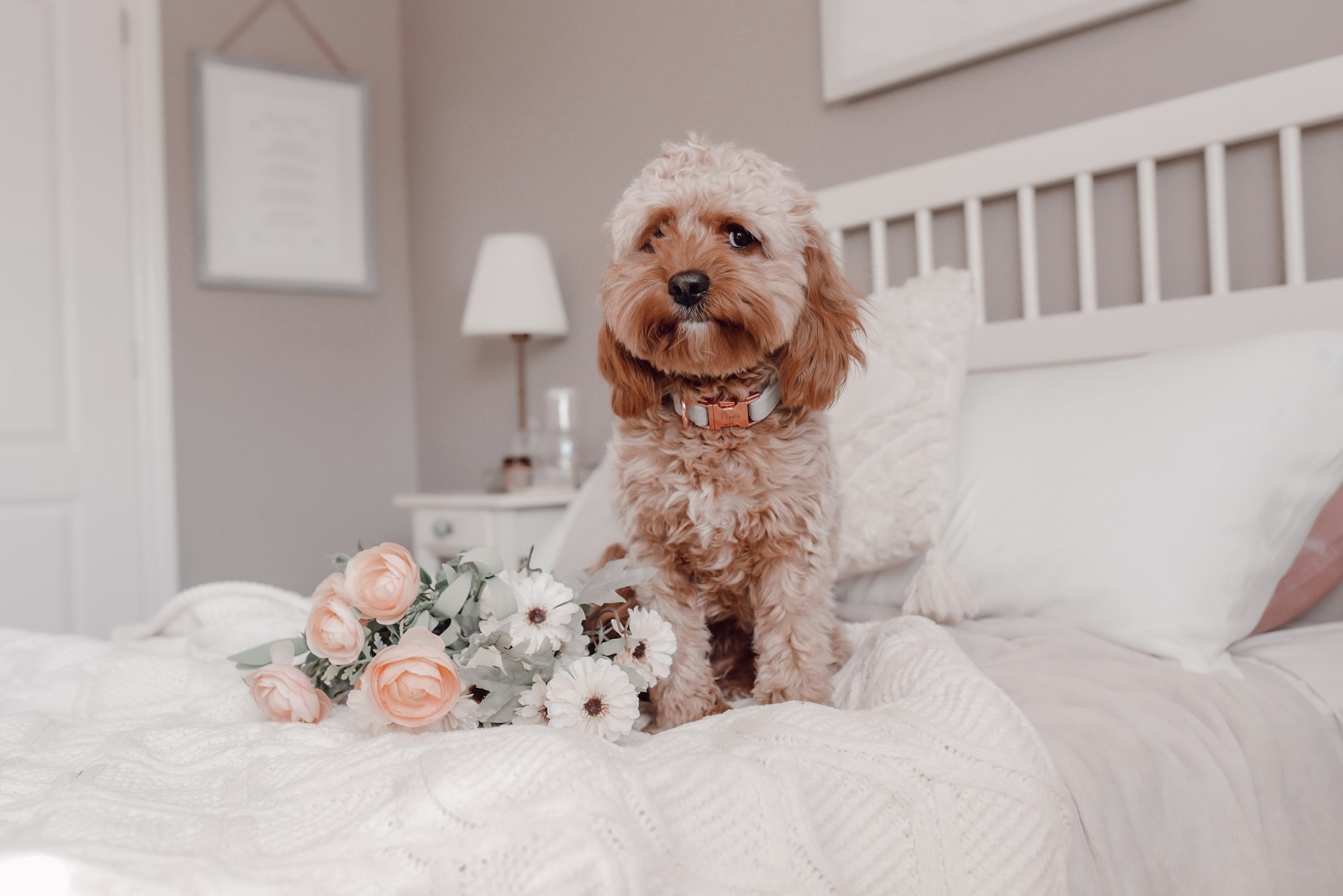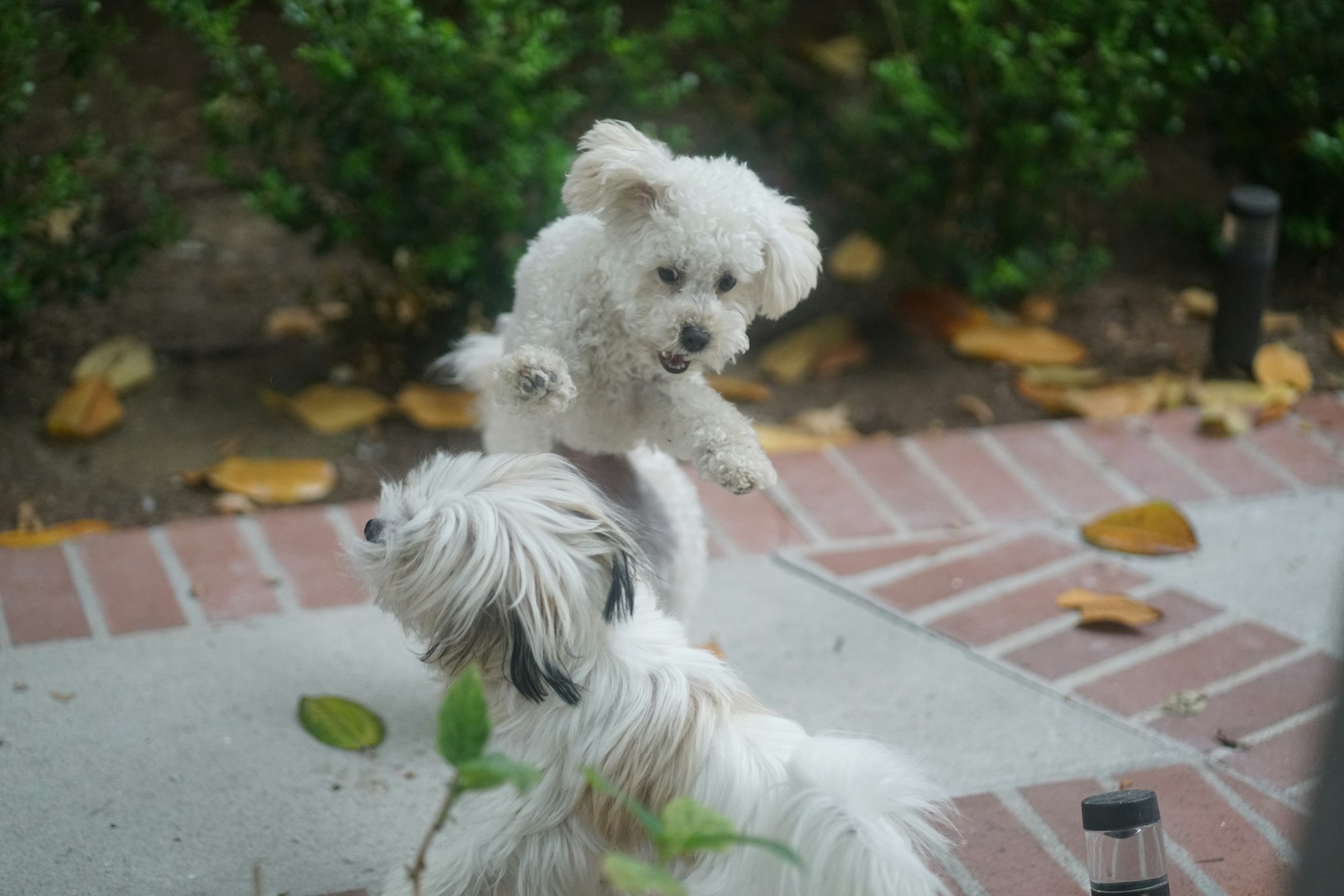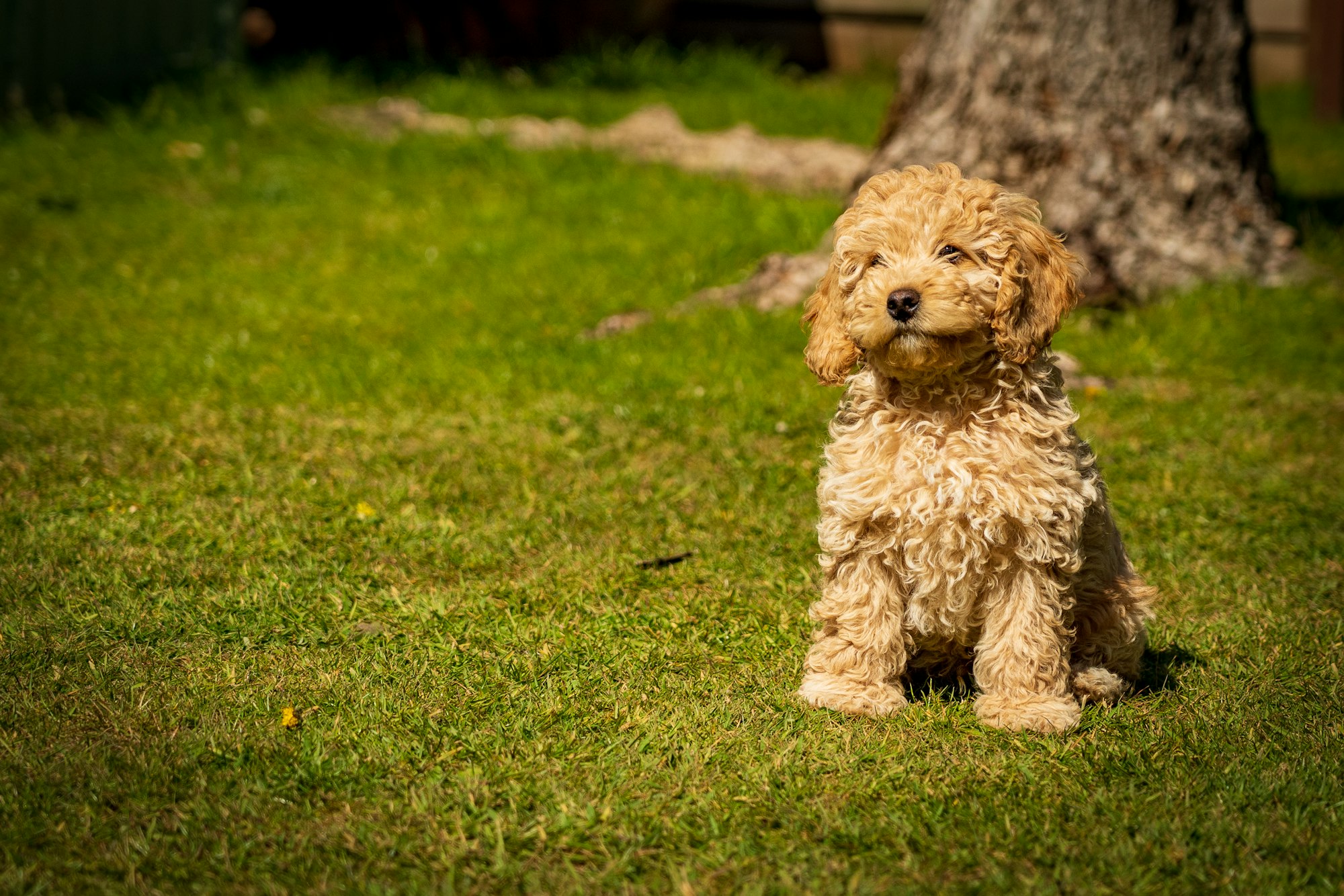Maybe you've seen pictures of these adorable pooches and are wondering just what kind of breed they are. Well, let us introduce you to the cuddly and curious Havapoo!
Read on to learn everything you need to know about this unique designer breed. We’ll start with what makes them special in terms of looks and temperament and end with their history as a mix between the Havanese and Poodle breeds.
What Is a Havapoo?
A Havapoo is one of the designer dog breeds in the craze that has swept the nation for the last few decades. This one is created by crossing a Havanese with a Poodle. They can also be called a Poovanese, Havadoodle, or Havanoodle.
These pooches are known for their playful personalities and fluffy coats, making the mix a highly sought-after pup. They're also incredibly smart, loyal to their owners, and easy to train, so they make great companions.
Despite being on the smaller side, they have big hearts and lots of energy — the perfect mixed breed for families who love to stay active together. Plus, they come in all sorts of colors, so you'll be sure to find just the right pup for your home!

Learn About The Parent Breeds
The Havanese
The Havanese is a small, fluffy dog breed that is native to Cuba. They are part of the toy group and are known for their playful and friendly personalities. Havanese are also intelligent dogs and are relatively easy to train.
The Havanese breed was recognized by the American Kennel Club (AKC) in 1996. Before that, the breed was recognized by the AKC's Foundation Stock Service (FSS), which is a program that tracks the development of new breeds.
One of the most notable features of the Havanese is their long, silky coat, which comes in a variety of colors including white, black, gold, and silver. The breed is hypoallergenic and does not shed, making them a popular choice for people with allergies.
In terms of personality, Havanese are known to be affectionate and loyal companions. They are great with children and get along well with other pets. Havanese are also social dogs and enjoy the company of their owners and other people. They are not prone to barking excessively and are generally well-behaved.
Despite their small size, Havanese are energetic and require daily exercise. They enjoy going on walks and playing games, but they can also adapt well to apartment living as long as they receive enough mental and physical stimulation.
Havanese have a lifespan of 12-15 years and are generally healthy breeds. However, like all breeds, they can be prone to certain health conditions such as hip dysplasia, cataracts, and patellar luxation. It is important to keep up with regular vet check-ups and maintain a healthy diet to help prevent any potential health issues.
In terms of grooming, Havanese require regular grooming to maintain their long, silky coat. This includes brushing, bathing, and trimming their nails. They also need to have their ears cleaned regularly to prevent ear infections.
Havanese are intelligent dogs and are relatively easy to train. They respond well to positive reinforcement and consistent training methods. It is important to start training and socialization at an early age to help ensure that they grow up to be well-behaved dogs.
Overall, the Havanese is a small, fluffy dog breed that is known for their affectionate and loyal personalities. They make great companion dogs and are well-suited for families with children. They are intelligent and easy to train, but do require regular grooming to maintain their long, silky coat. With proper care and attention, Havanese can make loving and loyal pets.

The Poodle
The Poodle breed is a popular dog breed that is known for their intelligence, athleticism, and distinctive appearance. They come in three sizes: Standard Poodle, Miniature Poodle, and Toy Poodle. The Poodle breed is easily recognized by their curly, hypoallergenic coat and long, elegant legs.
Poodles are one of the most intelligent and highly trainable dog breeds, making them a popular choice for service and therapy work. They excel in obedience and agility competitions and are also skilled at performing tricks. Poodles are known to be loyal and affectionate companions and get along well with children and other pets.
The Poodle breed has been recognized by the American Kennel Club (AKC) since 1887. The breed was originally classified in the Non-Sporting Group. The Toy Toy Poodle later moved to the Toy Group in 1971. Poodles are one of the oldest breeds recognized by the AKC and have a long history of being highly prized as companions and show dogs.
In terms of appearance, Poodles have a sleek, rectangular-shaped head and a long, straight muzzle. Their coat is curly and can be black, white, brown, apricot, or red in color. The breed has a dignified and graceful demeanor and is known for their high level of intelligence and athleticism.
Poodles require regular grooming to maintain their signature curly coat. This includes brushing, bathing, and trimming their nails. They also need to have their ears cleaned regularly to prevent ear infections. Poodles are generally healthy breeds, but like all breeds, they can be prone to certain health conditions such as hip dysplasia, diabetes, and bladder stones. It is important to keep up with regular vet check-ups and maintain a healthy diet to help prevent any potential health issues.
In terms of exercise, Poodles are energetic dogs and require daily physical activity. They enjoy going on walks, running, and playing games. They also benefit from mental stimulation, such as puzzle toys and training sessions. Poodles are adaptable dogs and can thrive in a variety of living environments, including apartments and houses.
Poodles have a lifespan of 12-15 years and are known to be one of the long-living dog breeds. They are intelligent and highly trainable dogs that make great companions for families with children. With proper care and attention, Poodles can make loving and loyal pets.

History of the Havapoo
The history of the Havapoo is not well documented, as the breed is relatively new and is not recognized by major kennel clubs such as the American Kennel Club (AKC). It is believed that the Havapoo was developed in the United States in the late 20th century as a designer breed.

Size and Weight
As a Havanese Poodle mix, the size of a full-grown Havapoo designer breed can vary considerably. Havanese are smaller dogs, ranging between 7 - 13 pounds. But remember that Poodles come in three sizes — toy, miniature, and standard. So it depends on the size of the parent breed.
The Havapoo is most often created with the miniature Poodle version (and sometimes the toy), meaning it tends to be a small dog. However, if a standard poodle is used in the cross, the pups can be a bit larger.
In general, Havapoos stand between 8-15 inches and can weigh between 10 - 45 pounds. However, most Havapoos will weigh in at 20 pounds or less. These small dogs are on the smaller side of all the most recent poodle mixes out there.
Havapoo Apperance and Colors
Both parent breeds come in a range of colors, so this Havanese Poodle mix comes in pretty much every color you can imagine. For starters, apricot, cream, fawn, brown, red, gray, white, and black are all colors you can find.
Plus, any of these colors can be mixed with white for the Havapoo coat. Some pups will have bi- or tri-color patterns, sport a tuxedo, the sable pattern, or even have spots! Whether you're looking for a classic look or something more exotic, there's sure to be a Havapoo out there with just the right hue to fit your style.

Do They Shed?
If you're looking for a low-maintenance pup that won't leave fur all over your furniture and floors, then this is the perfect breed for you!
Though few dogs are truly “hypoallergenic” these little cuties are often marketed as such. It’s true that they don't shed much thanks to their Poodle parent and they produce less dander and don’t drool. This means that allergy sufferers can usually tolerate these pups better than other types of dogs.
The quality of the Havapoo’s hair will vary depending on which traits they inherit from which parent. Some Havapoos have thick curly hair like a Poodle, whereas others enjoy the silky coat that is typical of the Havanese. Most end up somewhere in the middle with medium-length wavy or slightly curly hair.
Regardless, this hair will require regular brushing to avoid hair mats. It doesn’t take much, just a quick daily brush with a longer session about once a week or so. Almost all will have floppy ears and a fluffy tail.
Many owners take these quick grooming sessions as a special time to bond and play with their Havapoo pup. Every once in a while their hair should also be trimmed to keep it neat.
You must take special care to keep the hair short around their eyes and ears. The long hair can irritate their eyes and cause them to tear a lot, which leads to hair mats. Around their ears, it can make it hard to keep their ears clean. Thus, leaving the hair long can lead to skin or ear infections.

American Canine Hybrid Club
The American Canine Hybrid Club (ACHC) is an organization that recognizes and provides information on hybrid or designer breeds. A hybrid breed is a cross between two purebred dogs, resulting in a new breed that may exhibit characteristics of both parent breeds. The ACHC maintains a registry of hybrid breeds and provides information on the characteristics, personality, and potential health issues of these breeds.
The ACHC is not affiliated with the American Kennel Club (AKC), which only recognizes purebred breeds. Hybrid breeds are not recognized by the AKC and are not eligible to participate in AKC events or shows. However, the ACHC does hold its own events and shows for hybrid breeds.
The ACHC was founded in 1995 and is a nonprofit organization dedicated to promoting the responsible breeding and ownership of hybrid breeds. They provide resources and support for hybrid breeders and owners, as well as education on the importance of proper breeding practices and responsible pet ownership.
History of the Breed
The Havapoo is a relatively new designer breed, having only been around for about 20 years or so. The specific origin is not known, but they have popped up as a popular mix in the doodle breed craze.
The craze began when breeders crossed Labradors with Poodles trying to obtain a super intelligent and friendly dog to train as a service dog. And it took off from there.
The Havanese Poodle mix was probably an attempt to create the perfect companion pup. The Havanese pup, which originated in Cuba, has a very friendly and affectionate personality. Combine that with the intelligence and hypoallergenic coat qualities of a Poodle and it does seem like a match made in heaven.
And it looks like they succeeded! These pups are now loved all over the world for their friendly personalities, intelligence, and loyalty. Individuals vary, of course, but most Havapoos are easy to train, full of energy, and always up for hugs and cuddles!
Plus, with such an adorable coat that comes in all sorts of colors, you can't help but fall head over heels for these little bundles of joy!
A Havapoo for Your Home
Are you considering bringing a little Havapoo puppy into your home? Regardless of the individual traits of the pup you pick, you’ll get a loving companion that you can’t imagine living without! Make sure that you find a reputable breeder or adopt one from a local shelter.
Overall, the Havapoo is a great family dog that gets along well with small children and other pets. He doesn't shed much and is always up for adventure and cuddles. Your pup and your family will always have lots to do together and you won’t spend hours cleaning dog hair off your couch.
If you're looking for a loyal furry friend, then the cuddly and curious Havapoo may be your ideal pup.
Visit the Off Leash blog at TryFi.com for more helpful articles about pet-parenting tips.
Would you like to learn more about TryFi.com? The Fi Dog Collar is a GPS tracking collar that not only tracks your dog's location, activity level, and sleep pattern, but also alerts you if your dog escapes. If your dog escapes, this is the fastest way to find him. Give the Fi Dog Collar a try today!

